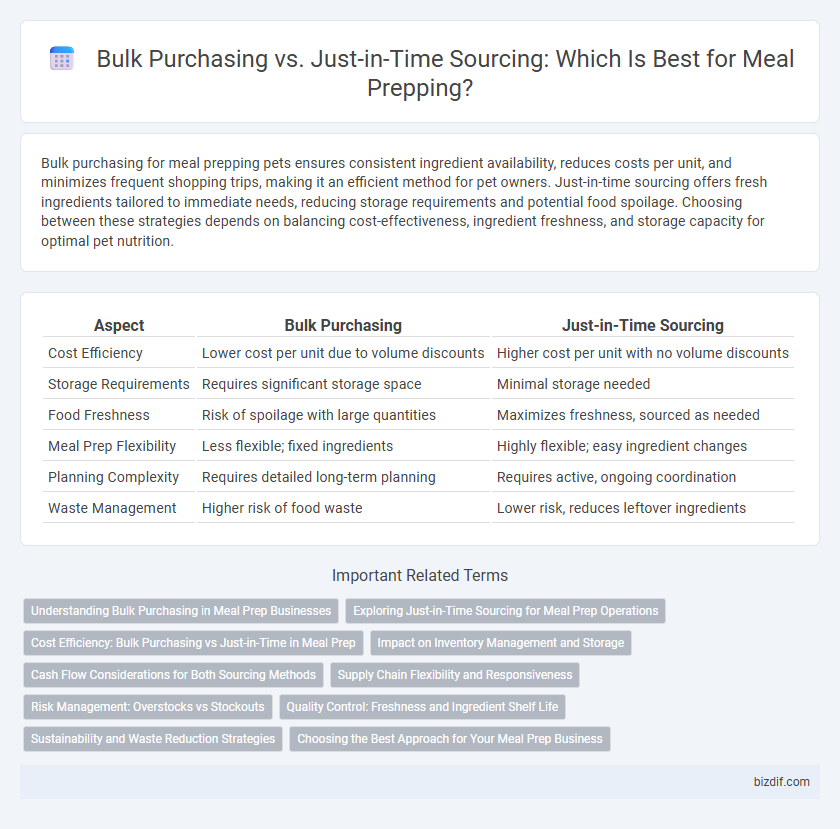Bulk purchasing for meal prepping pets ensures consistent ingredient availability, reduces costs per unit, and minimizes frequent shopping trips, making it an efficient method for pet owners. Just-in-time sourcing offers fresh ingredients tailored to immediate needs, reducing storage requirements and potential food spoilage. Choosing between these strategies depends on balancing cost-effectiveness, ingredient freshness, and storage capacity for optimal pet nutrition.
Table of Comparison
| Aspect | Bulk Purchasing | Just-in-Time Sourcing |
|---|---|---|
| Cost Efficiency | Lower cost per unit due to volume discounts | Higher cost per unit with no volume discounts |
| Storage Requirements | Requires significant storage space | Minimal storage needed |
| Food Freshness | Risk of spoilage with large quantities | Maximizes freshness, sourced as needed |
| Meal Prep Flexibility | Less flexible; fixed ingredients | Highly flexible; easy ingredient changes |
| Planning Complexity | Requires detailed long-term planning | Requires active, ongoing coordination |
| Waste Management | Higher risk of food waste | Lower risk, reduces leftover ingredients |
Understanding Bulk Purchasing in Meal Prep Businesses
Bulk purchasing in meal prep businesses leverages economies of scale to reduce ingredient costs and streamline inventory management. It enables consistent ingredient availability, minimizing disruptions caused by supply chain delays or market fluctuations. Effective bulk sourcing requires precise demand forecasting and adequate storage capacity to prevent spoilage and maintain food safety standards.
Exploring Just-in-Time Sourcing for Meal Prep Operations
Just-in-time sourcing in meal prep operations minimizes inventory costs by receiving ingredients precisely when needed, reducing food waste and storage requirements. This approach enhances freshness and allows for greater flexibility in adjusting menus based on real-time demand and seasonal availability. Efficient coordination with suppliers and reliable delivery schedules are critical to successfully implementing just-in-time sourcing strategies.
Cost Efficiency: Bulk Purchasing vs Just-in-Time in Meal Prep
Bulk purchasing in meal prepping reduces per-unit costs by leveraging economies of scale, minimizing frequent transaction fees, and cutting down on packaging waste. Just-in-time sourcing, while reducing storage needs and spoilage, may incur higher costs due to smaller order sizes and potential last-minute price surges. Evaluating cost efficiency between bulk purchasing and just-in-time sourcing hinges on balancing inventory holding expenses against price advantages of large-scale procurement in meal prep operations.
Impact on Inventory Management and Storage
Bulk purchasing in meal prepping reduces per-unit costs by acquiring large quantities at once, but it increases storage requirements and the risk of food spoilage due to extended inventory holding times. Just-in-time sourcing minimizes storage needs and waste by ordering ingredients closer to use, promoting fresher meals but requiring precise coordination and reliable supplier relationships. Efficient inventory management balances these approaches, optimizing storage space and ensuring ingredient freshness while controlling costs.
Cash Flow Considerations for Both Sourcing Methods
Bulk purchasing in meal prepping requires larger upfront cash outlays but reduces the frequency of purchases, improving cost efficiency and inventory stability. Just-in-time sourcing minimizes initial cash expenditure and storage needs but may lead to higher per-unit costs and potential supply disruptions impacting meal prep schedules. Balancing cash flow involves weighing bulk buying's capital lock-in against just-in-time's operational agility to optimize meal prep budgeting and resource allocation.
Supply Chain Flexibility and Responsiveness
Bulk purchasing in meal prepping enhances supply chain flexibility by securing large quantities of ingredients, reducing the risk of stockouts and allowing for consistent meal production. Just-in-time sourcing increases responsiveness by acquiring fresh ingredients closer to meal preparation, minimizing waste and adapting quickly to changing demand. Balancing both strategies optimizes inventory management while maintaining agile operations in meal prep supply chains.
Risk Management: Overstocks vs Stockouts
Bulk purchasing in meal prepping reduces the risk of stockouts by ensuring a consistent supply of ingredients, but it increases the likelihood of overstocks that can lead to food waste and higher storage costs. Just-in-time sourcing minimizes overstock risks by ordering ingredients as needed, yet exposes meal preppers to potential stockouts due to supply chain disruptions or demand fluctuations. Effective risk management balances inventory levels, leveraging data-driven demand forecasting and supplier reliability to optimize ingredient availability while controlling costs and waste.
Quality Control: Freshness and Ingredient Shelf Life
Bulk purchasing in meal prepping ensures a consistent supply of ingredients but requires rigorous quality control to maintain freshness and prevent spoilage due to extended shelf life. Just-in-time sourcing minimizes storage time, preserving ingredient vitality and enhancing meal flavor but relies heavily on vendor reliability and precise timing. Balancing these approaches depends on effective inventory management and real-time monitoring of ingredient quality metrics.
Sustainability and Waste Reduction Strategies
Bulk purchasing minimizes packaging waste and reduces carbon emissions associated with frequent deliveries, supporting sustainable meal prepping practices. Just-in-time sourcing aligns inventory closely with consumption patterns, effectively reducing food spoilage and minimizing organic waste. Combining both approaches strategically enhances sustainability by optimizing resource use and waste reduction in meal prep routines.
Choosing the Best Approach for Your Meal Prep Business
Bulk purchasing reduces costs per unit and ensures consistent ingredient availability, ideal for high-volume meal prep businesses with predictable demand. Just-in-time sourcing minimizes inventory storage and waste, benefiting smaller operations or those with fluctuating menus. Evaluate your business scale, storage capacity, and demand variability to select the most efficient procurement strategy for your meal prep venture.
Bulk purchasing vs Just-in-time sourcing Infographic

 bizdif.com
bizdif.com